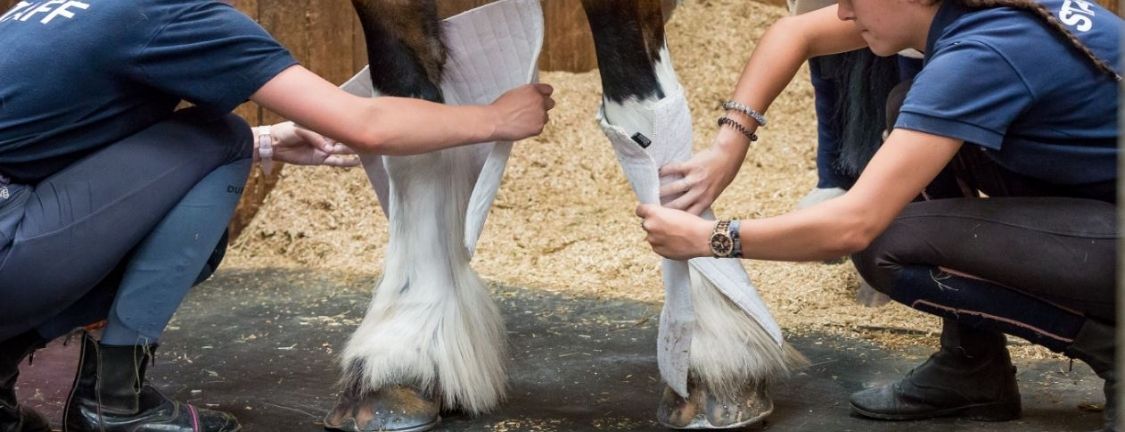
A survey of horse owners in the UK* revealed that the average vet bill for treating accidental injuries was £1200. To ensure your horse heals from these injuries as swiftly as possible, we spoke to Brian Reed from Rainbow Equine to get advice on when to call the vet what to do ahead of the vet arriving and when to treat a wound yourself.
The words "horse first aid" are enough to fill any horse owner with dread, so just what is the right thing to do? It's likely that as a horse owner you've dealt with a variety of accidental horse injuries over the years and we hope this blog gives you the basics to establish when to call the vet and when to treat a wound yourself.
Accidents can and do happen, UK horse owners reported the below injuries to be the most common horse injuries and accidents*:
Top 3 horse injuries:
- Flesh wounds
- Puncture wounds
- Eye wounds
How did they happen?
- Being kicked by another horse
- Ran through a fence
- The horse pulled back when it was tied up
Your horse suffers an accidental injury - how should you treat it and when do you call the vet?
The importance of knowing horse first aid
During the spring and summer months vets tend to see a lot of horses with field injuries, Brian calls it “spring fever”. Many horses have had limited or no turnout during the long winter months and they’re now behaving like spring lambs. Typical accidents are caused by horses running through fences, attempts to jump from one field to another, kicking and biting each other. Mares are coming into season and for many, the grass is greener on the other side – sadly some of these antics result in injuries.
Brian advises that if you find your horse with an injury the first thing to do is assess the degree of pain and lameness. If you have called the vet, take some photos of the injury to send to the vet before they arrive to help them assess and treat the horse as quickly as possible upon arrival.
When to call the vet
Call the vet if your horse is displaying any of these signs:
- Excessive blood loss
- Straw coloured serum type discharge from the wound
- Small puncture into the deeper structure of the horse, or near joints, tendons and tendon sheath
- Hanging flaps of skin
Brian explains that many horse owners cover the wound with lotions and potions. However, this can mean that it’s difficult for the vet to see the injury clearly and they will therefore need to clean the wound before any treatment can be carried out. Also, don’t try to clean a flesh wound with lots of water as tissue absorbs water causing swelling which makes stitching difficult. Tissue injuries that are stitched will heal quicker - if there is a flap of skin it really is best that the vet is called to stitch it as recovery should be faster.
The basics of first aid for horses
For smaller horse injuries that you can treat yourself, injuries that are not displaying any of the above signs, Brian recommends the following treatment:
- Clean the wound with sterile saline. This can be bought from your local chemist in sealed tubes or sprays.
- If the skin is not broken hosing the injury will help with swelling.
- For broken skin, if the location of the wound allows, apply a sterile wound dressing - make sure you have a selection of different sizes. Again, these are available from your chemist. Then apply a thick cotton wool bandage for protection and keep it in place with a self-sticking bandage such as the flex-wrap available at harryhall.com
*Survey of Harry Hall One Club members in June 2019 (222 respondents)
Have you got the right vet fees cover? Click here to explore Harry Hall vet fees insurance.
About Brian Reed:
Brian was brought up in the Scottish Borders in a family with a strong veterinary background - he is the 4th generation to take up the profession. He graduated from Glasgow University Veterinary School in 2003 and after a brief spell working for his father’s practice, he moved to a large farm animal and equine practice on Teeside. Brian moved to Rainbow Equine in 2008 to pursue his passion for equine practice, specifically reproduction, lameness investigation and pre-purchase examinations.
Brian gained the RCVS certificate in equine practice in 2010 and became a Director of Rainbow Equine Hospital in 2015. Brian is an FEI Permitted Treating Vet and has provided veterinary services at many national and international Eventing and Dressage competitions. He is also an Official Veterinarian (OV), enabling him to perform equine export examinations and certification. Brian leads the breeding services at Rainbow and enjoys working with performance horses.
Rainbow Equine Hospital is the largest fully-equipped RCVS Tier 3 Equine Referral Hospital in the North East of England. Rainbow offers advanced diagnostic and surgical techniques in state-of-the-art facilities and is staffed with progressive specialists in equine soft-tissue and orthopaedic surgery, internal medicine, and diagnostic imaging.

